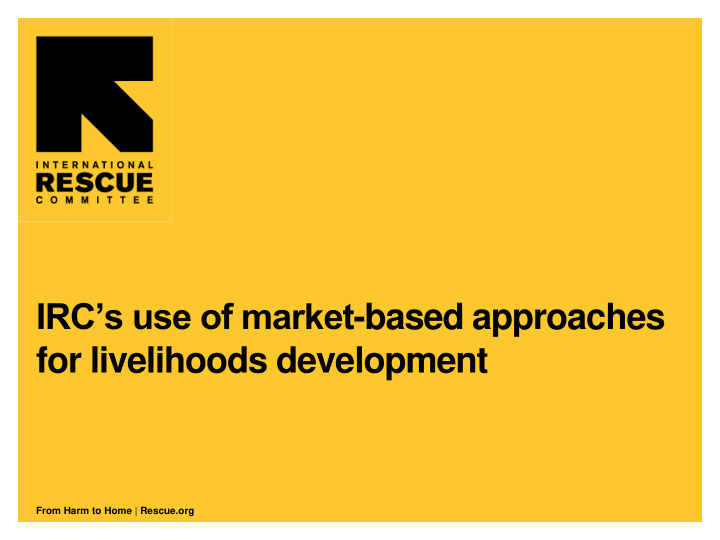



IRC’s use of market -based approaches for livelihoods development From Harm to Home | Rescue.org
Goal: Resilience The people we serve, especially women, youth and children, can mitigate and recover from conflict and natural disaster so that they are thriving and transforming their lives Increased income for those living on less than $2 per day Improved wellbeing through food security, nutritional status, psychosocial development, access to services, and agency and voice Reduced risk of violence, exploitation and abuse against women and children Connecting Building a pathway Increasing economic from livelihoods preparedness as outcomes to protection to promotion first-responders wellbeing and violence prevention context analysis targeting learning 2 From Harm to Home | Rescue.org
3 From Harm to Home | Rescue.org
Economic Recovery Who is involved? and Develop ment Research, Youth and Evaluation Livelihoods and Learning Market- based programs Women’s Protection Nutrition and Empower- ment US Programs 4 From Harm to Home | Rescue.org
Economic Recovery Who is involved in and Microfranchising? Develop ment Research, Youth and Evaluation Livelihoods and Learning Market- based programs Women’s Protection Nutrition and Empower- ment US Programs 5 From Harm to Home | Rescue.org
A sad and frustrating story… 6 From Harm to Home | Rescue.org
7 From Harm to Home | Rescue.org
Insanity: Doing the same thing over and over again and expecting different results Albert Einstein 8 From Harm to Home | Rescue.org
9 From Harm to Home | Rescue.org
IRC’s approach: • Youth selection; • Business selection; • Microfranchise business model development; • Youth training; • Product/ service training; • Savings-led financial services; • MoUs between businesses, youth and IRC; • Microfranchise start-up; 10 From Harm to Home | Rescue.org
Results from pilot • 100% of youth were still engaged in their micro- franchises seven months after start-up; • 83% of youth reported making a profit and 16% of youth reported breaking even seven months after start-up; • 100% of youth in Freetown and 48% of youth in Kenema opened savings accounts with local retail banks; • 43% of youth reported saving money as their primary investment for profits; 11 From Harm to Home | Rescue.org
Girls Empowered by Microfranchise (GEM), Kenya Objective: 2400 girls supported to operate their own microfranchise Activities: • Design microfranchise models with selected businesses • Train, monitor and support girls to engage in microfranchise businesses • Evaluate 12 From Harm to Home | Rescue.org
facilitator Who is involved? IRC resource Nike Foundation, Local partners trainers World Bank, training Youth Employment providers Network, IZA GEM IPA, Open Population Council,. Capital World Bank management research Darling, consultants Kenchic, partners Dlight, Pure- business Flow franchisors 13 From Harm to Home | Rescue.org
Results to date http://www.bbc.co.uk/news/business-20300644 14 From Harm to Home | Rescue.org
Commitment to learning Key research questions: - What is the impact of microfranchising on economic and wellbeing indicators? - What factors create this impact? - How does the impact of microfranchising compare to a training, mentoring and cash grant model? 15 From Harm to Home | Rescue.org
Key program questions: - How can new applications of microfranchising be applied e.g. rural livelihoods/ production franchising? 16 From Harm to Home | Rescue.org
Questions for discussion What do you see as the critical success factors for microfranchising in your context? What do you see as barriers to use of microfranchising in your context? What would you want to learn in relation to the application and efficacy of microfranchising? 17 From Harm to Home | Rescue.org
Recommend
More recommend